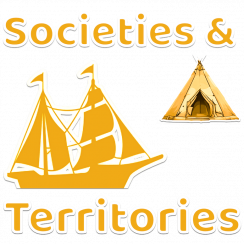
7. Settlement
First Homes
Most Loyalists built houses as soon as possible, choosing land that had been “burned over” or in a marsh to avoid having to fell trees. These first log cabin homes were quite small. Fifteen or 20 feet square, they had eight-foot high walls and only one window made of glass given by the army. Some had mud or clay-lined wood chimneys; others had simply a hole in the roof for the smoke to escape. The floor was trampled earth or rough boards cut as smooth as possible with an axe. Sometimes the door was just a blanket.
Once a family had a home they turned their attention to clearing land, planting food and building barns and enclosures for their animals. Only after such things were done would a family begin to build a more comfortable house. The first home was then used as a chicken coop or pigsty.
Help from the government
Since many had left with so few possessions, they needed basic materials and tools to begin their lives in British North America. New arrivals were given a blanket, a tent for every five people, and one kettle for each tent. Tools necessary for cutting and building, such as saws, chisels, hammers, axes and sickles were also given to the Loyalists.
For the first three years families were given rations of pork, peas, beef, flour, butter, and salt. They added to this by hunting and fishing, and as soon as they could they planted wheat, peas, corn and potatoes from seeds given by the government.
Clothing was also given to settlers. Men and boys were given coats, waistcoats, breeches, shirts, legging, stockings and soles for shoes. Women and girls were also given stocking and shoes soles, but instead of pre-made clothing they were given yards of cloth and had to make their own dresses. They made additional clothing from the skins of animals they hunted and trapped.
Community
In the three years during which the government aided the settlers families did their best to become independent. People came together to work, the women quilting, carding wool or shelling corn together to make boring jobs more fun, men working together to clear land, build barns or do other jobs too difficult to complete without many workers. Children would have a chance to see each other while they played and helped with what jobs they could. There was much work to be done, but communities found ways of working together and finding time to socialize and support each other.
Neighbours also helped each other in times of need. When there was illness, and accident or a baby about to be born, neighbours would be sent for and would come to help.
Community was important in times when pulling together was the only means of survival. When the rations ended some families had a hard time providing for themselves, and 1788-1789 became know as the “Hungry Year.” At the same time that the rations ended crops failed to thrive due to lack of rain, and by mid-winter many families had little to eat. Some families were desperate enough to risk returning south, but those who stayed depended on each other to work together.

